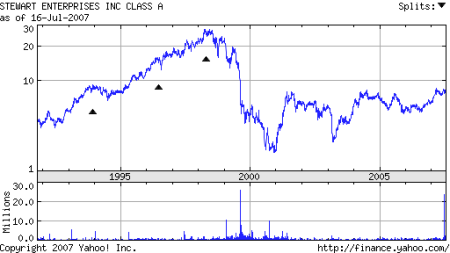“I talk in the book(Dhandho Investor) about this concept of low risk, high uncertainty. So there’s a perception that entrepreneurs are risk takers. Well, in reality entrepreneurs avoid risk. They try to minimise risk… They do absolutely everything to absolutely minimise the downside. But they are also humans that are very comfortable with uncertainty. So they can believe a wide range of outcomes and be very comfortable.”
“You don’t try and buy businesses worth $83 million for $80 million. You leave yourself an enormous margin. When you build a bridge, you insist it can carry 30,000 pounds, but you only drive 10,000 pound trucks across it. And the same principle works in investing”
Pabrai believes that buying at a low enough price will help to mitigate the risk.We shall look into the Stewart Entreprise case study to get a better glimpse of his thought process.
Stewart Enterprises (STEI) is the second largest company in the “death care” industry worldwide. Stewart has about $700 million in annual revenues and owns about 700 cemeteries and funeral homes in nine countries, with the bulk of them in the United States.
- Stewart was trading at about $2/share for several months during Q3 and Q4 of 2000.
- At the time, Stewart had a book value of $8.50/share. It was thus trading at less than ¼ of book value.
- At the time, Stewart’s free cash flow was about $0.72 cents/share. The stock was trading at less than 3 times cash flow
- In a business with predictable cash flows
Risk
Highly leveraged company with 500 in debt due in 2002
Wall Street assumed company would default and market forces drove the stock down to $2
Possible scenarios
Over the next 2 yrs
1.Management decides to sell off the numerous family owned funeral homes it had acquired over the years. The company would raise enough capital to meet debt obligations
2. Based on the predictable solid cashflows the business was generating, it could ask bankers/ /lenders for loan extensions
3.Stewart Entreprises goes into bankruptcy and is forced by courts to restructure ( e.g. selling off assets to raise capital )
Pabrai believed that the stock was mispriced at $2/share and calculated an intrinsic value of at about $4/share based on higher P/FCF multiple (from 3x FCF to 5-7 x FCF) .He bought shares at $2/share in Q3 and Q4 of 2000 In Q4 2000, Stewart Enterprises announced plans to sell off the funeral homes and this drove the share price higher to $4/share by Q1 2001
Pabrai had made an almost 100% gain in Steward Enterprises(<9mths)
Conclusion
1.Understanding the business model is crucial
2.Distinguish between risk and uncertainty. There was high uncertainty surrounding Stewart Enterprises but it was a low risk to shareholders (i.e. Stock was trading at 3x FCF and ¼ of book value)
3.High uncertainty but low risk events such as Stewart Enterprises can provide v high returns (i.e. 100% gain <9mths)>
